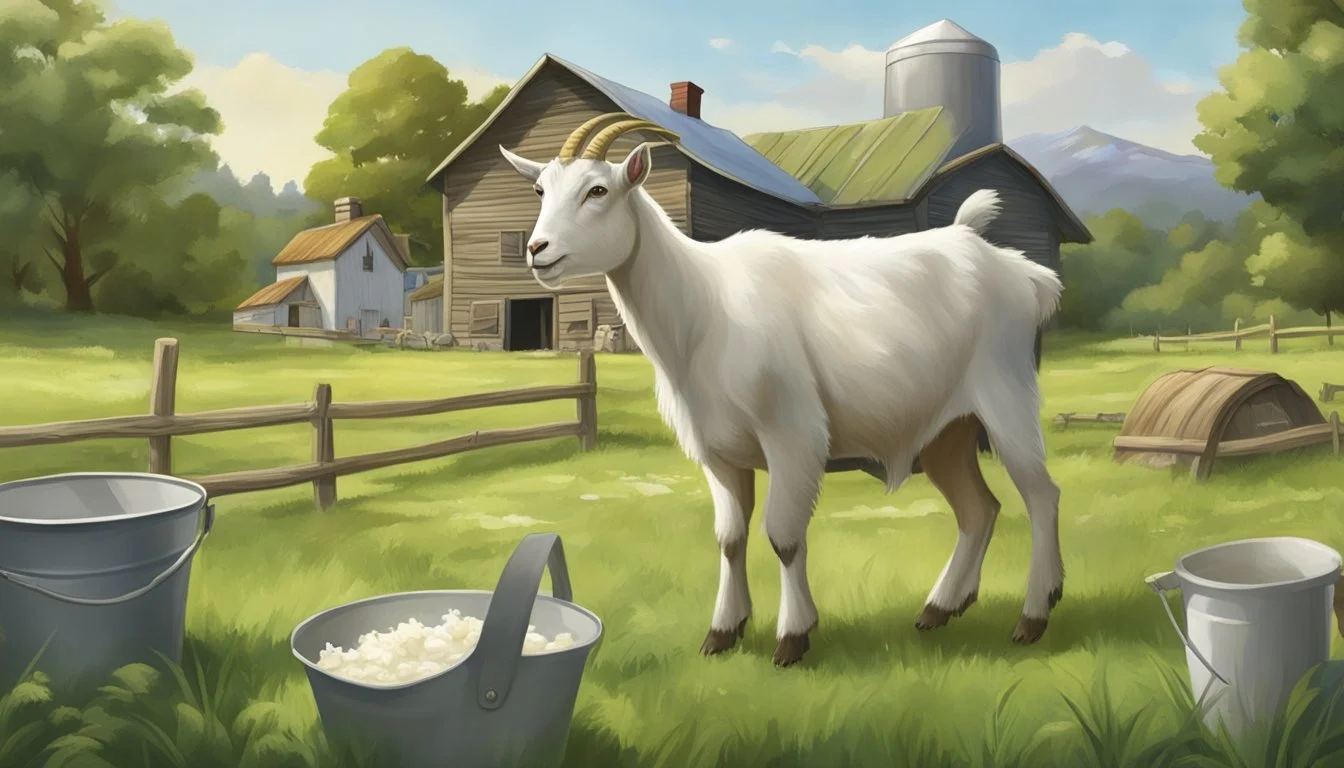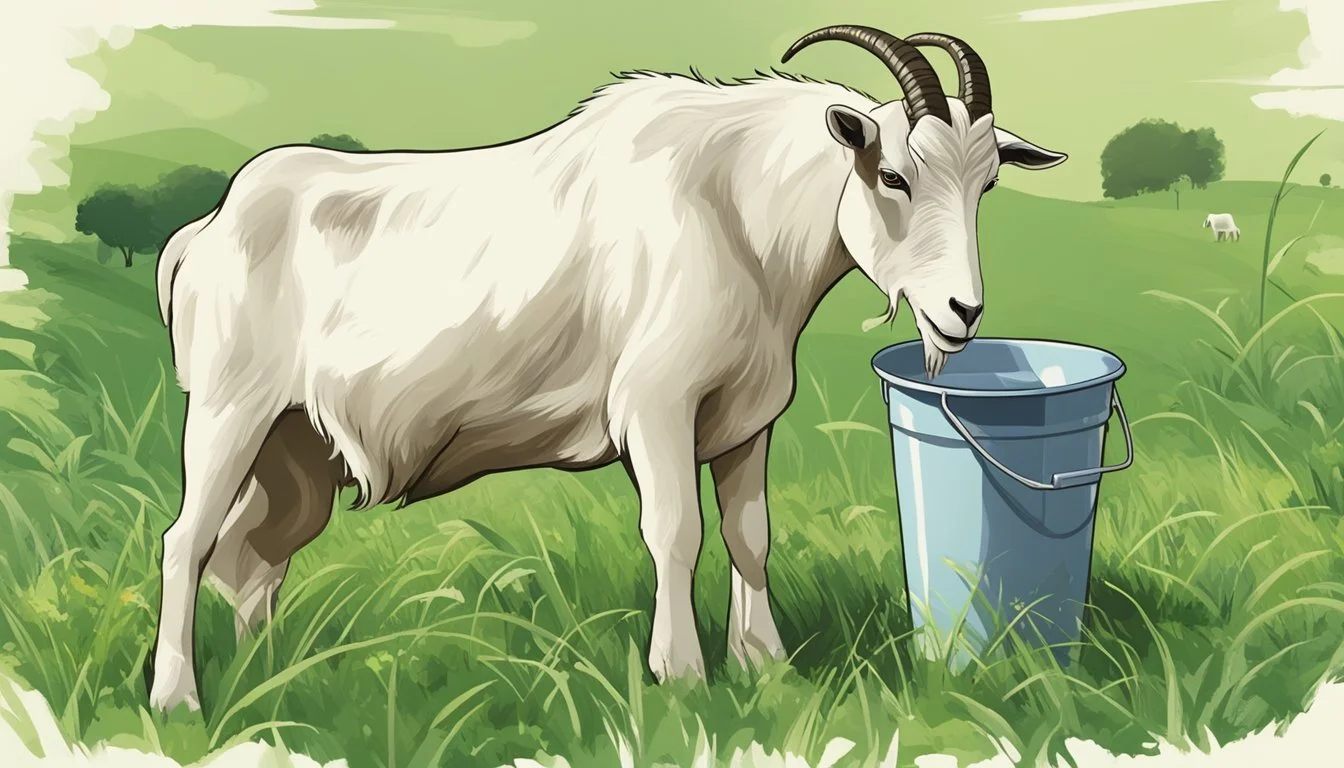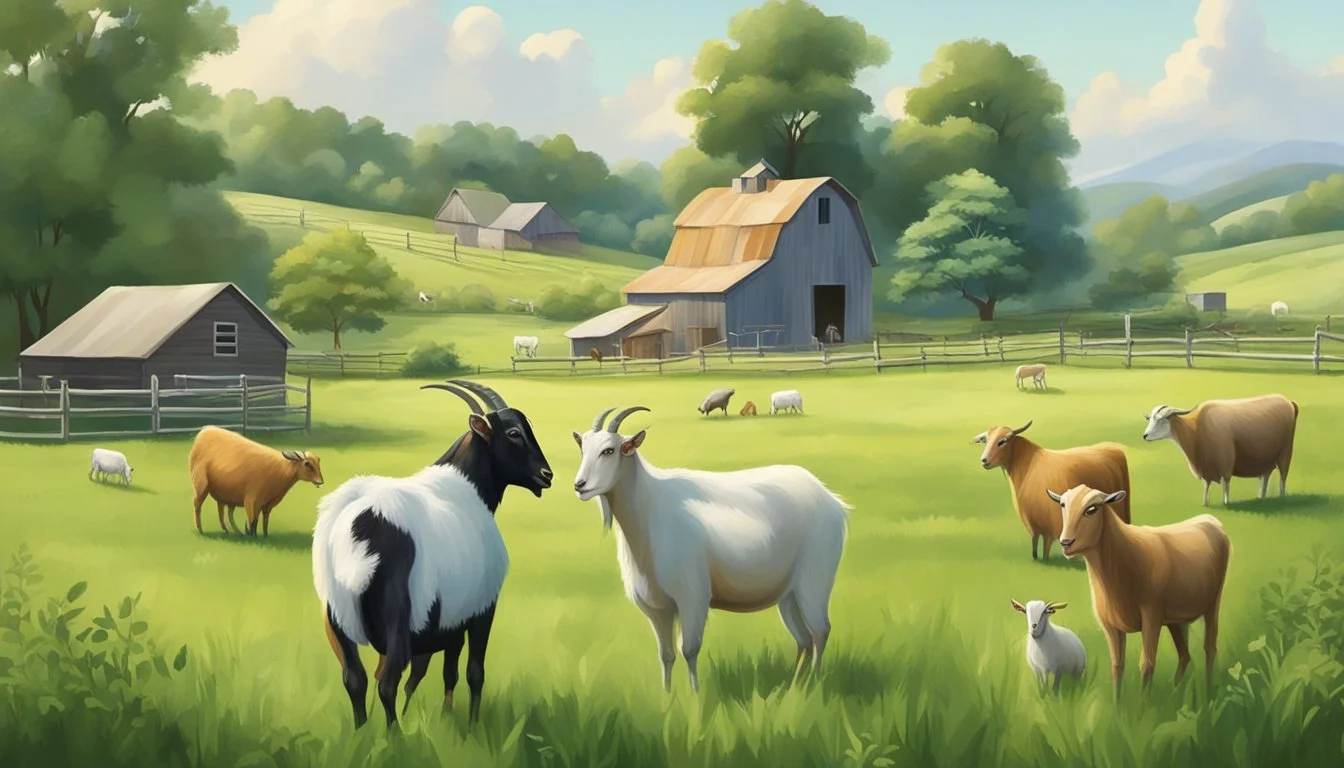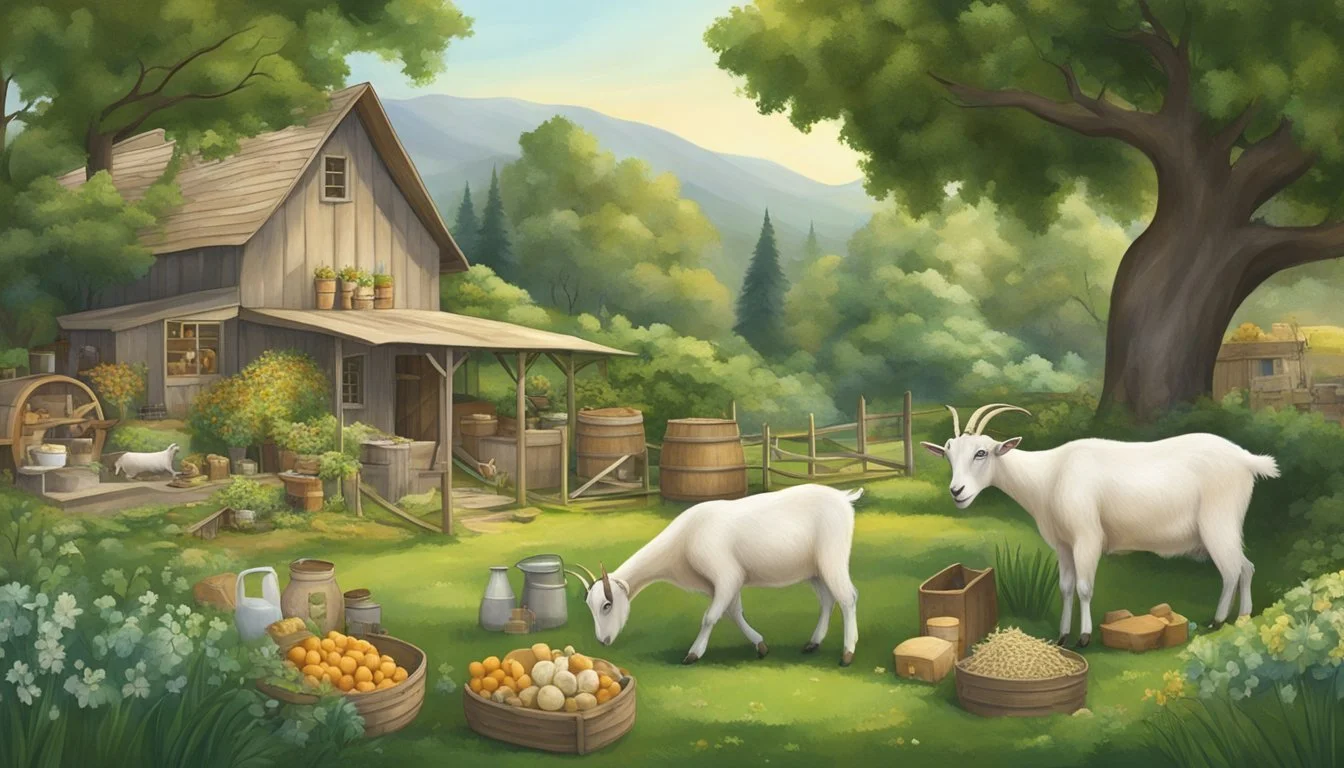The Economic Benefits of Adding a Milking Goat to Your Homestead
A Cost-Saving Move
Adding a milking goat to a homestead can be a practical and financially savvy decision for those looking to augment their self-sufficiency and economic stability. Goats provide a source of high-quality milk that can be turned into various dairy products such as cheese, yogurt, and soap. This not only reduces the dependency on store-bought goods but also allows for potential savings. The economic benefits of goat milk production are tangible, especially when considering the increasing cost of dairy products in retail settings.
The routine of milking goats offers more than just milk; it brings a rhythm to daily life on the homestead and can improve overall animal management. When compared to the cost of purchasing milk from the supermarket, maintaining a dairy goat or a small herd can result in considerable monthly savings. For example, a family's consumption of 1-1.5 gallons of milk daily could otherwise amount to a monthly expense of over one hundred dollars.
By introducing dairy goats to a homestead, individuals gain a readily available food source that contributes positively to both household economics and the environment. Goats are known for their sociable and trainable nature, which makes them suitable for a variety of homestead setups. They are not only efficient converters of fodder into valuable products but also serve as effective agents in land regeneration through their grazing habits.
Understanding Goat Milk Production
When considering the addition of a dairy goat to a homestead, understanding the intricacies of goat milk production is crucial. Factors such as milk composition, management practices, and biological cycles all play significant roles in maximizing yields and ensuring a profitable venture.
Goat Milk vs. Cow's Milk
Composition: Goat milk is distinguished by its easier digestibility, higher fat content, and the presence of A2 beta-casein, making it a preferred choice for many with lactose sensitivities or digestive concerns. Taste: It tends to have a creamier texture and a unique flavor profile that varies with the doe's diet. Nutritional Content: It is rich in essential nutrients, such as calcium and potassium.
Dairy Breeds: Saanen, Nubian, and LaMancha are among the breeds renowned for their higher milk output and quality.
Factors Affecting Milk Yield
Genetics: A dairy goat's genetic makeup is a key determinant of its potential milk production. Selective breeding can optimize this trait. Diet & Nutrition: Proper nutrition, including a balanced mix of forage, grains, and minerals, is critical for high milk yields.
Health Management: Routine health checks and preventive care ensure that does maintain optimal milk production levels.
Environmental Factors: The living conditions, including shelter and space, can affect a goat's stress levels and milk output.
Optimizing Lactation Cycles
Milking Frequency: Consistent milking, typically twice a day, is necessary to sustain milk production and prevent issues such as mastitis. Breeding Cycle: Understanding and managing the goat's breeding cycle is important to plan for breaks in lactation and ensure the health of both the doe and future kids.
Managing Dry Periods: Implementing a dry period before kidding helps to maximize milk production for the subsequent lactation cycle.
The Economics of Dairy Goats
The addition of dairy goats to a homestead can result in significant economic benefits through the generation of income and a good return on investment (ROI) given their small size and manageable purchase costs.
Initial Investment and ROI
Dairy goats require a relatively low initial investment compared to other livestock. A pair of quality dairy does can range from $200 - $500, which is quite affordable for a homesteading operation. The ROI is favorable, considering goats' ability to produce milk and offspring. With efficient care, the sale of milk, kids, and other dairy products can begin to recoup costs within the first year or two.
Comparing Goat Breeds for Profitability
When selecting a breed, profitability should be a key consideration. Some of the most popular dairy breeds include the Nubian, known for high butterfat content, the Saanen, appreciated for its large volume of milk, and the Alpine, favored for its consistent milk production. Researching the specific milk yield, feed efficiency, and adaptability to various environments can help determine the most profitable breed for a homestead's specific conditions.
Dairy Products Marketability
The marketability of dairy products is an essential factor in the economic analysis of dairy goats. Homesteaders can sell surplus goat milk or create value-added products such as cheese, yogurt, or soap. The niche appeal of goat milk and its products has increased in demand, but it's important to be aware of local regulations, like those mentioned in Indiana, that can affect the ability to sell unpasteurized milk. Proper marketing and adherence to regulations are vital to tapping into the growing market for goat dairy products.
Feeding and Nutrition
Proper feeding and nutrition are pivotal for optimizing milk production in dairy goats. They require a balanced diet rich in energy, protein, and minerals to ensure high-quality milk output and maintain their overall health.
Essential Diet Components for Milk Production
Dairy goats need a well-rounded diet to produce milk efficiently. This diet must include forage, such as hay, which is essential for the rumen to function properly and aids in digestion. Grain mixtures are also important as they provide additional energy and protein that forage alone might lack. Critical to a lactating goat's diet is a high level of calcium to support milk production and prevent health issues such as hypocalcemia.
Sourcing Quality Feed
It is vital to source high-quality feed for dairy goats. Hay should be clean, mold-free, and composed of a mixture of grasses and legumes for a balanced nutrient intake. If available, alfalfa hay is a good choice for its higher calcium and protein content, which is beneficial for milk production. When selecting grain, it is imperative to choose a formulation specifically designed for dairy goats to ensure it meets their unique nutritional needs without causing obesity.
Supplements and Minerals
Even with a well-planned diet, goats may still require additional supplements and minerals to fulfill their nutritional requirements. Essential minerals like calcium and phosphorus should be provided in the correct ratios to promote bone health and milk production. A proper mineral mix designed for dairy goats should be readily accessible to these animals at all times to safeguard against deficiencies. Minerals also play an important role in various bodily functions and help protect against diseases.
Housing and Shelter Needs
When adding a milking goat to a homestead, one must ensure that the animals have the proper housing and shelter that cater to their health and productivity. Good design, security, and adequate space are paramount.
Designing a Functional Goat Barn
A functional goat barn is crucial for the wellbeing of milking goats. It must provide a dry, clean, and draft-free environment. The interior should include features for easy feeding, milking, and cleaning. For example, shelter considerations may include a dedicated area for milking and storage for feed and equipment. Ventilation is important to maintain air quality without causing cold drafts.
Fencing and Security
Fencing serves multiple purposes: it keeps goats safe from predators and prevents them from wandering off and damaging crops. Fences should be strong and high enough to discourage jumping. Electric fencing or chain-link materials offer additional security, but consider the goat sheds and shelters that can combine safety with the goats' need for play and exploration.
Space Requirements and Land Utilization
The amount of space required for each goat typically ranges from 12 to 20 square feet within a shelter. However, land and climate can influence these numbers. In warmer climates with ample pasture, goats may need less indoor space. They must have enough room to move, rest, and engage in natural behaviors. Proper land utilization includes areas for grazing, which reduces feed costs and keeps goats healthy. Land must also allow for rotation to avoid overgrazing and maintain pasture health. Housing must consider space for both the goats and their human caretakers to move comfortably and safely.
Health and Daily Care
Maintaining the health of a milking goat is crucial for both the animal's wellbeing and the productivity of your homestead. A regular and comprehensive approach to health and daily care is the backbone of successful goat rearing, from routine veterinary visits to impeccable cleanliness during milking.
Routine Veterinary Care
They should schedule routine veterinary visits to ensure their goats remain in optimal health. These visits often include vaccinations, general health check-ups, and dental care. It is imperative for the goat owner to establish a relationship with a vet who is knowledgeable in caprine care ensuring that any health issues are swiftly addressed.
Parasite Prevention and Control
Effective parasite management is essential in maintaining a goat's health and productivity. Owners should implement a strategic approach to parasite prevention and control, which typically involves regular fecal exams and a deworming schedule tailored to the specific needs of their herd. Additionally, they should monitor their goats for signs of parasitic infections, such as anemia or lethargy, and have a treatment plan in place.
Milking Hygiene and Health
The hygiene of the milking process cannot be overstressed as it directly impacts milk quality and the health of both the goats and consumers. They must always wash their hands and the goat's udder before milking, use clean equipment, and promptly chill the milk after milking. A clean and stress-free milking environment helps in preventing the spread of bacteria and maintains the goat's health and comfort.
Breeding and Reproduction
In the context of homesteading, the breeding and reproduction of milking goats form the crux of sustaining a productive dairy operation. Attention to breed selection, the timing of breeding cycles, and the care of does and their offspring are paramount for a successful endeavor.
Selecting Breeds for Milking
When choosing a breed for milk production on the homestead, one must consider factors such as milk yield, fat content, and temperament. The Nubian breed, known for its high butterfat content, and the Alpine breed, popular for its abundant milk supply, are excellent choices for those looking at both quality and quantity of milk. The Toggenburg breed balances good milk production with resilience to cooler climates, while the Nigerian Dwarf is a smaller breed that yields milk with high butterfat.
Managing the Breeding Cycle
To maintain a steady supply of goat milk, it's critical to properly manage the breeding cycle. Most dairy goat breeds are seasonal breeders, coming into heat in the fall. By accurately tracking estrus signs and planning breedings accordingly, a homesteader can ensure a well-timed labor and subsequent milk production. Advanced reproductive technologies can also help to overcome challenges with the intrinsic seasonality of estrus in dairy goats.
Caring for Kids and Does Pre- and Post-Parturition
Proper care of both kids and does before and after giving birth ensures the health of the herd and the success of the milking operation. Providing a clean, stress-free environment and adequate nutrition supports a smoother labor and healthy kids. Post-parturition care includes monitoring the doe for any signs of complications and ensuring kids receive colostrum soon after birth. Vaccinations and deworming are integral parts of managing the health of both kids and does.
Sustainability and Environmental Impact
Milking goats offer homesteaders an opportunity to implement eco-friendly practices, manage waste effectively, and maintain sustainable pastures. These initiatives are integral to reducing the homestead's environmental impact and fostering a self-reliant lifestyle.
Eco-Friendly Practices
Raising dairy goats supports a sustainable lifestyle by requiring less land and food resources compared to traditional livestock. Their ability to forage and browse allows them to consume a variety of plant species, including those that are unpalatable to other farm animals. This diverse diet helps in [managing grass and weed growth], reducing the need for chemical herbicides, which aligns with eco-friendly farming principles.
Waste Management
Effective waste management strategies are crucial in homesteading to minimize environmental impact. Goat manure is a valuable by-product, serving as a high-quality fertilizer rich in nitrogen. It can be composted and used to enhance soil fertility, thus closing the nutrient loop on the homestead and decreasing reliance on chemical fertilizers.
Pasture Management
Implementing rotational grazing systems is pivotal for pasture management on a homestead. By regularly moving goats to fresh areas of grass, homesteaders optimize the growth of vegetation and prevent overgrazing. This practice ensures soil health, reducing erosion and promoting a sustainable impact on land resources.
Homestead Goat Products
Adding a milking goat to a homestead opens up a world of opportunity for producing a range of valuable dairy products. This can transform fresh goat milk into a variety of goods, from traditional foods to handcrafted soaps, enriching both the homesteader’s table and potential market offerings.
Creating Value-Added Products
Milking goats provide an essential ingredient: milk. This fresh input is ideal for creating value-added products such as cheese, butter, and yogurt. For example, one can produce artisanal cheeses with distinct flavors unique to goats' milk. Additionally, crafting homemade butter and yogurt can lead to delicious alternatives to store-bought varieties.
Recipes and Usage Ideas for Goat Milk
Fresh goat milk can be used directly in numerous recipes, ranging from savory dishes to sweet desserts. Here are a few ideas:
Cheese: Soft chevre or a firm cheddar.
Butter: Creamy and spreadable for fresh bread.
Yogurt: Thick and tangy, perfect for breakfast or as a base in sauces.
Desserts: Substituting cow's milk with goat's milk in puddings and pastries.
These homemade dairy products ensure one knows exactly what goes into their food, allowing for healthier and more conscious eating choices.
Marketing Homemade Goat Products
Homesteaders can market their goat milk products to help sustain their homesteading operations. They should adhere to local regulations while selling at farmers' markets or to neighbors. Packaging plays a crucial role; consider including a personal touch, like a custom label, to help stand out. Networking with local chefs or health food stores can also create additional avenues for sales. Homemade products like goat milk soap are popular due to their natural properties and appeal to eco-conscious consumers.
Legal Considerations and Selling Products
Before adding a dairy goat to your homestead and selling products, it's essential to understand the legal landscape and prepare adequately. Selling dairy requires navigating through state-specific regulations and understanding the implications of selling raw versus pasteurized milk.
Regulations on Dairy Sales
Each state has its own laws regarding the sale of dairy products. Generally, individuals must obtain a license to sell dairy products such as goat milk, cheese, and yogurt. Beyond licensure, one might consider alternative models like herd sharing, which allows customers to buy a share in the goat and legally obtain milk as part of their ownership, within certain jurisdictions. To initiate selling dairy products from a homestead, research into local laws is a non-negotiable first step.
Licensing: Determine the necessary permits based on state regulations.
Labeling: Accurate product labels as per food laws must be prepared.
Inspections: Be prepared for routine inspections by health departments.
The goal is to ensure that the business enters the market in full compliance with existing food and dairy sales laws.
Raw Milk vs. Pasteurized: Understanding the Rules
The sale of raw milk—milk that has not been pasteurized to kill bacteria—comes with stringent rules. Some states allow the sale of raw milk directly to consumers, while others prohibit it entirely. By contrast, pasteurized milk, which has been heat-treated to kill pathogens, typically faces fewer restrictions. Individuals considering the sale of raw milk must adhere strictly to the following:
Testing: Regular testing for pathogens as mandated by local laws.
Labeling: Clear labeling as "raw milk" and potential health advisories.
Understanding the contrast between rules governing raw and pasteurized milk is crucial for legal operation and consumer safety.
Setting Up a Dairy Goat Business
When transitioning from homestead goat milk production to a viable business, one encounters several important factors. First, a business plan is crucial for mapping out the financial, marketing, and operational aspects of the venture. Second, insurance for liability and property is vital to mitigate risks associated with commercial dairy production. Lastly, marketing efforts should not be underestimated, as building a customer base is a central pillar for success.
Business Planning: Create a detailed plan covering production goals and costs.
Insurance: Invest in comprehensive coverage to protect the business.
Marketing: Develop strategies to attract and maintain a strong customer base.
By understanding these legal and business considerations and establishing a systematic approach, the integration of dairy goats onto a homestead and into the marketplace can be both rewarding and profitable.







